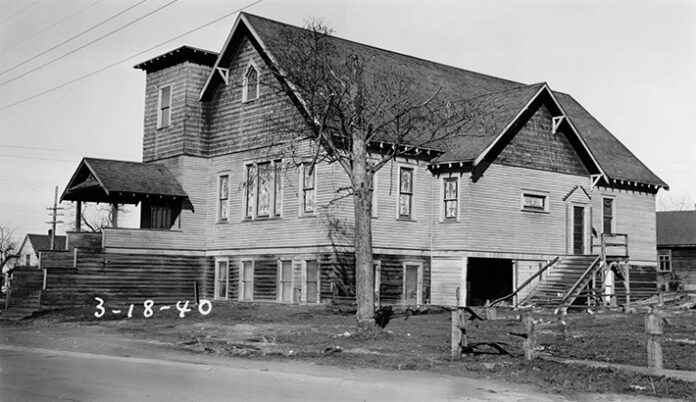Last week’s column featured a 1914 photo of Black Diamond’s First Presbyterian Church. Located at what is now 4thAvenue and Lawson Street, it was built about the same time as St. Barbara’s Catholic Church situated 250 yards to the northeast.
On Sept. 26, 1910, Mrs. Jane (Powell) Allen turned the first shovel of dirt at a service organized by the Seattle Presbytery to mark the start of construction. The first wedding at the new Presbyterian Church was solemnized at noon, Sunday, Oct. 25, 1914, when Miss Beatrice Jones, daughter of Mr. & Mrs. John O. Jones, and Mr. Lindley O. Newton were united in marriage by Rev. W.H. Hoole, the church pastor. About 250 guests attended. Following the service the guests enjoyed a breakfast served at the Black Diamond home of the Jones.
Though the church looks huge in this March 18, 1940 King County Assessor photo, its total square footage is only 2,928, about 20% larger than the 2,450-sf average size of a newly constructed single-family home in Washington State. The structure had two water fixtures, a sink and a toilet, and was heated by a coal stoker situated in the basement. Summer cooling was provided by overhead fans.
The worship space on the second floor featured 12 to 14-foot ceilings. The windows were stained glass. There were meeting rooms in the basement, plus attic space with a height of six to eight feet. The ceilings were covered in Beaver Board, a trademarked lumber product manufactured from white spruce by the Beaver Manufacturing Company of Buffalo, New York. The wood plank flooring was 1” x 4” tongue and groove. The exterior siding was cedar shiplap. At the time of its Jan. 1, 1940 assessment, the building was valued at $1,320.
Coal mining was a dangerous occupation, and the church saw its share of miner funerals. One of the last occurred after Harry English was trapped by a Jan. 7, 1954 cave-in at the Landsburg Mine in Ravensdale. Though his 25-year-old partner, Roy Coutts of Cumberland survived, efforts to recover English were called off three days later when conditions grew too dangerous for rescue workers.
Harry J. English’s body was never recovered, so plans were made to erect a tombstone above the accident site. His widow, Lily English abandoned that idea requesting that a lighted cross be placed against a background of maroon velvet in the Presbyterian Church sanctuary. The April 4th dedication service was conducted by Reverend David H. Weed, in the presence of Lily and her two sons, James English, age 16, and Jerry English, age 11.
Nearly five years to the date after Harry English’s death, the lighted cross was destroyed by a raging fire that completely consumed the entire church. The early morning blaze of Jan. 5, 1959 broke out in the basement furnace room. The building was almost completely wood, and flames were visible throughout Black Diamond.
In Sept. 1959, the Presbyterian Church purchased 1.67 acres from the Black Diamond Fraternal Order of Eagles. The property was located two blocks east of the original church site, on Lawson Street between 5th and 6th Avenue. The purchase price was $1,000 on a deed signed by the Eagles Chairman, Joe Dal Santo and notarized by Frank R. Costi, its secretary. Costi had negotiated the Eagles’ 1945 purchase of the property from Pacific Coast Coal Company. It was the former site of Black Diamond Coal Mining Company’s Mine No. 2. The new church was completed in 1962 and measured over 9,000 square feet, triple the size of the former building. The property is still owned by the Presbyterians and leased to Imagine Church co-founded by Robert and Annie Wachter.
This King County Assessor photo of tax parcel 084400-0980 comes courtesy of the Puget Sound Regional Archives. Historical research was provided by JoAnne Matsumura of Issaquah, while photo enhancements were undertaken by Boomer Burnham, a Tahoma photography instructor whose website is: https://www.boomersphotography.com/







